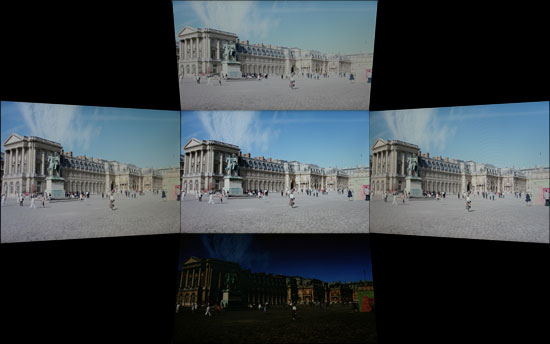Viewing Angles
Viewing angles are one of those specifications that have become very inflated by the manufacturers. The basic requirement is that a display has to maintain a 10:1 contrast ratio in order to qualify as "viewable". The reality is that most LCDs are unfit for viewing beyond a 45° angle. The good news is we doubt that most people will view a display from anything more than a 45° angle, and typically a lot less. For that reason, we used our camera to take shots from head-on as well as from the left and right sides at ~30° angles, showing how brightness and contrast ratios are affected in off-angle viewing. We also took pictures from above and below at ~30° angles. Links to the viewing angle images of previously reviewed LCDs are available for comparison below:
Acer AL2216W
Dell 2405FPW
Dell 2407WFP
Dell 2707WFP
Dell 3007WFP
Gateway FPD2485W
HP LP3065
Before we get to comments on the w2207 viewing angles, we do need to make a note of the fact that we have adjusted the settings on our camera slightly in order to provide a more accurate rendition of what we see with our eyes when looking at the LCDs. The results are not exactly the same as in previous LCD reviews, but they are generally close. We recommend that you focus more on the LCD currently being reviewed, as the above images are not a strict apples-to-apples comparison.
Within our 60° viewing arc, the colors and image quality of the w2207 clearly betrays the use of a TN panel. There are differences between the Acer and HP, and we generally felt that the HP looked a bit better in vertical viewing while the Acer is better in the horizontal plane. Regardless, both are clearly behind any of the other LCDs that we've looked at so far. If you're concerned with viewing angles but you don't want to spend the money on a 24" or larger LCD, we would recommend dropping down to a 20" offering that uses an S-IPS or S-PVA panel. Both of those technologies provide much better viewing angles, as you can gather from the above images.
Viewing angles are one of those specifications that have become very inflated by the manufacturers. The basic requirement is that a display has to maintain a 10:1 contrast ratio in order to qualify as "viewable". The reality is that most LCDs are unfit for viewing beyond a 45° angle. The good news is we doubt that most people will view a display from anything more than a 45° angle, and typically a lot less. For that reason, we used our camera to take shots from head-on as well as from the left and right sides at ~30° angles, showing how brightness and contrast ratios are affected in off-angle viewing. We also took pictures from above and below at ~30° angles. Links to the viewing angle images of previously reviewed LCDs are available for comparison below:
Acer AL2216W
Dell 2405FPW
Dell 2407WFP
Dell 2707WFP
Dell 3007WFP
Gateway FPD2485W
HP LP3065
 |
Before we get to comments on the w2207 viewing angles, we do need to make a note of the fact that we have adjusted the settings on our camera slightly in order to provide a more accurate rendition of what we see with our eyes when looking at the LCDs. The results are not exactly the same as in previous LCD reviews, but they are generally close. We recommend that you focus more on the LCD currently being reviewed, as the above images are not a strict apples-to-apples comparison.
Within our 60° viewing arc, the colors and image quality of the w2207 clearly betrays the use of a TN panel. There are differences between the Acer and HP, and we generally felt that the HP looked a bit better in vertical viewing while the Acer is better in the horizontal plane. Regardless, both are clearly behind any of the other LCDs that we've looked at so far. If you're concerned with viewing angles but you don't want to spend the money on a 24" or larger LCD, we would recommend dropping down to a 20" offering that uses an S-IPS or S-PVA panel. Both of those technologies provide much better viewing angles, as you can gather from the above images.










43 Comments
View All Comments
JarredWalton - Wednesday, August 1, 2007 - link
For $1700, I would definitely pick up one of the HP 30 inch LCDs -- or the Dell that matter. Both of those used S-IPS panels and provide back lighting that has an improved color gamut. I certainly couldn't tell you what the NEC offers that would make it worth the price of entry, but unfortunately I have never been able to use one in person.nilepez - Wednesday, August 1, 2007 - link
I think the difference is that the HP apparently has a lot of adjustments that you can make.I'm just guessing, but it may be something like the the old Sony Artisan or Barco monitors, where you could make adjustments to many different areas of the screen, not just the usual 4 (or less) that most had.
strikeback03 - Thursday, August 2, 2007 - link
IIRC some of the high-end Eizo and NEC displays can interface directly with color calibration equipment, and probably have better controls. Who knows, they migh hold their color longer or come with a calibration sheet from NIST or something too. Conceptually similar to the Artisans as a monitor designed to be very good for color-sensitive work.